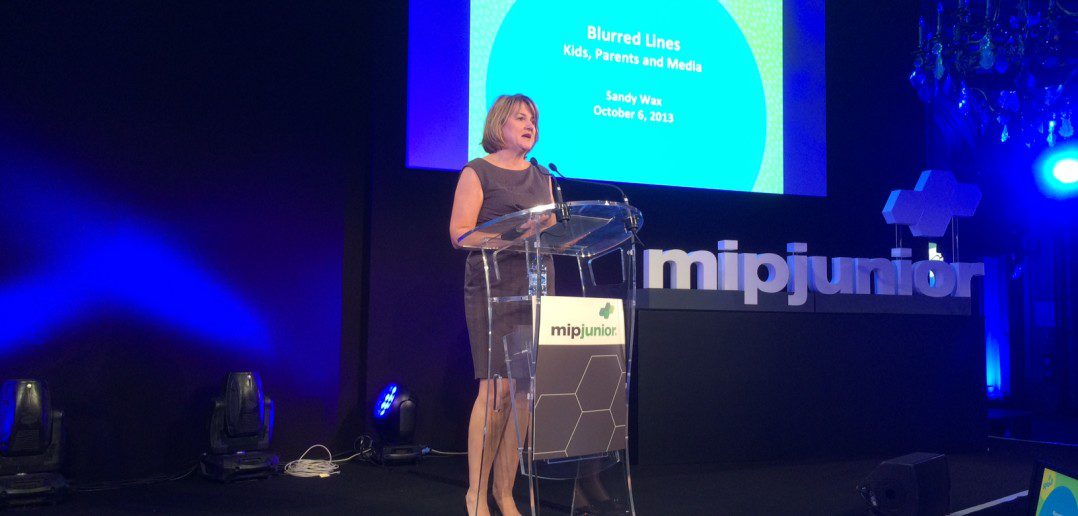After a day of apps, YouTube and cross-platform innovation at MIPJunior, time to hear from a senior executive who operates both in the broadcast network space, and the exploding world of video-on-demand.
Sandy Wax is president of Sprout, the 24-hour preschool network that launched eight years ago in the US, and is now available in more than 55m homes, having notched up more than 1.5bn video-on-demand views. Wax was interviewed on-stage for a Media Mastermind keynote session by Peter White, senior international reporter at Broadcast magazine.
“We encourage parents and preschoolers to come together and interact on-screen and off-screen in a way that’s inviting, fresh, playful and real,” said Wax. So while Sprout is aimed at 2-5 year-olds, there’s a strong emphasis on parents joining in, even after the TV is switched off.
Wax said there’s so much of a focus on digital kids, but not enough on the role parents play in children’s media adoption and choices. “The values and habits of parents are really key determinant of the child’s orientation towards media,” she said, showing some stats indicating that 70% of parents of children aged eight and under use computers with their children, 63% use smartphones with them, and 62% use iPads and other tablets.
In 2005, Sprout was conceived as a multi-platform offering: a cable channel, rich video-on-demand service and a website. “We had the luxury of starting with a blank piece of paper,” said Wax. “We had a wonderful library of much-loved content including Sesame Street, Barney and Caillou.”
But the launch team also asked itself questions about what role digital and interactive media would play, as well as when families would want on-demand videos, and what the appeal of linear TV would still be. Linear TV is current, in the moment, shared and communal, and good for discovering new shows.
On-demand is “purposeful: I need to watch that episode 300 times”, said Wax. But it’s less about discovery than linear is. And digital is interactive, a connection into Sprout, it can be portable, and it’s open distribution: people can use the Sprout website without needing a specific cable subscription.
There is some intentional blurring of the lines: when people are watching the linear channel, sometimes they’ll see a pop-up message suggesting they switch to on-demand to help their children feel sleepy by watching a suitable video. “We’re the only network that intentionally tries to make our audience fall asleep!” she joked.
Now, Sprout is pushing into the digital space with 13 apps, investing more in original series like preschool sitcom The Chica Show, musical shortform show Sing It Laurie, upcoming live-action-meets-CG sow Floogals, and animated comedy Astroblast, which launches in July 2014.
Ruff-Ruff Tweet and Dave, meanwhile, will be an animated game show with a second-screen playalong experience for smartphones and tablets: more blurring of the lines, this time between linear TV and digital. “This is the world we live in, lines are going to keep blurring and become more blurred,” she said.
Sprout is US-only, which Wax says opens up lots of opportunities to do co-productions with international companies: it’s not looking for worldwide rights. She was asked what she’d look for at a market like MIPCOM.
“You can listen and see what new ideas are coming out. Obviously things like second-screen are all the rage, so it’s interesting to see where that’s going. But we’re looking for content that’s really innovative, particularly from a cross-platform standpoint.”
Wax said Sprout isn’t wedded to a particular genre or format, and is obviously looking for shows made strictly for its audience of preschoolers: “You can’t make a show for nine year-olds and dumb it down for a younger audience,” she said. And Sprout is also looking for “embedded, organic learning” in shows. Could Sprout be commissioning for digital in order to seed ideas for traditional TV? “Absolutely, we’re getting pretty close to that,” she said.
Wax talked about Sprout’s app plans, fielding a question about whether the apps will be marketing for the main channel and service, or revenue-generating products in their own right.
“As the app market evolves, there’s probably a broad free component and possibly a gated area where it’s more monetiseable,” she said. “But we’re pretty new, we’ve been around for eight years… so we want the apps to also drive awareness and drive demand. Primarily we’re using the apps as promotional extensions, but I do see that opportunity going forward.”




